เปรียบเทียบผลลัพธ์ของการผ่าตัดถุงน้ำดีแบบกล้องวีดิทัศน์ระหว่าง เทคนิค combine retrograde caudal-antegrade cranial approach และเทคนิค retrograde caudal approach ในโรงพยาบาลสมุทรปราการ
คำสำคัญ:
การผ่าตัดถุงน้ำดีแบบกล้องวีดิทัศน์, เทคนิค Retrograde caudal approach, เทคนิค Antegrade cranial approach, การบาดเจ็บของท่อน้ำดี, การรั่วของท่อน้ำดีบทคัดย่อ
ภูมิหลัง: การผ่าตัดถุงน้ำดีแบบกล้องวีดิทัศน์ด้วย เทคนิค retrograde caudal approach อาจทำให้เกิดการบาดเจ็บของท่อน้ำดี และความล้มเหลวการผ่าตัดแบบกล้องวีดิทัศน์ ในรายที่มีการอักเสบของถุงน้ำดี แบบกระจาย ส่วนการผ่าตัดถุงน้ำดี แบบกล้องวีดิทัศน์ด้วยเทคนิค antegrade cranial approach พบว่าทำให้เกิดการบาดเจ็บของหลอดเลือด การบาดเจ็บของท่อน้ำดีเป็นภาวะแทรกซ้อนที่รุนแรง และอาจทำให้เกิดภาวะทุพพลภาพและเสียชีวิต ดังนั้นผู้วิจัยจึงปรับเทคนิคการผ่าตัดถุงน้ำดี แบบกล้องวีดิทัศน์ เพื่อลดภาวะแทรกซ้อน และความล้มเหลวจากการผ่าตัดโดยเรียกเทคนิคนี้ว่า combine retrograde caudal-antegrade cranial approach
วัตถุประสงค์: เพื่อเปรียบเทียบผลลัพธ์ของการ ผ่าตัดถุงน้ำดีแบบกล้องวีดิทัศน์ ด้วยเทคนิค combined retrograde caudal -antegrade cranial approach กับ เทคนิค retrograde caudal approach ในโรงพยาบาล สมุทรปราการ
วิธีการ: การศึกษานี้ เป็นการศึกษาย้อนหลังโดยการเก็บข้อมูล จากเวชระเบียนผู้ป่วยที่ได้รับการผ่าตัดถุงน้ำดี แบบกล้องวีดิทัศน์ ตั้งแต่ 1 มกราคม 2560 ถึง 30 มิถุนายน 2562 แบ่งเป็น 2 กลุ่ม คือ กลุ่มที่ผ่าตัดแบบเทคนิค retrograde caudal approach และ กลุ่มที่ผ่าตัดแบบเทคนิค combined retrograde caudal-antegrade cranial approach นำมาวิเคราะห์ข้อมูลพื้นฐาน การวินิจฉัยก่อนและหลังผ่าตัด ข้อมูลการผ่าตัด ข้อมูลภาวะแทรกซ้อนจากการผ่าตัด และนำข้อมูลที่ได้มาคำนวณทางสถิติ
ผล: จากการรวบรวมข้อมูลทั้งหมด จำนวน 323 ราย กลุ่มแรกคือผ่าตัดแบบเทคนิค retrograde caudal approach จำนวน 171 ราย กลุ่มที่สองผ่าตัดแบบ เทคนิค combined retrograde caudal -antegrade cranial approach จำนวน 152 ราย ระยะเวลาผ่าตัดกลุ่มที่สองสั้นกว่ากลุ่มแรก อย่างมีนัยสำคัญทางสถิติ (43.5 นาที และ 50 นาที, p = 0.002) ระยะเวลานอนโรงพยาบาล กลุ่มที่สองสั้นกว่ากลุ่ม แรกอย่างมีนัยสำคัญทางสถิติ (3 วัน และ 4 วัน, p value = 0.02) ภาวะล้มเหลวของการผ่าตัดแบบกล้องวีดิทัศน์ ในกลุ่มที่สองน้อยกว่าเมื่อเทียบกับกลุ่มแรกอย่างมีนัยสำคัญทางสถิติ (3.9% และ 9.9%, p = 0.03) กลุ่มที่สองพบการบาดเจ็บ ของท่อน้ำดีน้อยกว่ากลุ่มแรกอย่างมีนัยสำคัญทางสถิติ ( 0.7% และ 6.4%, p = 0.006) เลือดออกจากหลอดเลือดของท่อน้ำดี ในกลุ่มที่สองพบน้อยกว่ากลุ่มแรก อย่างมีนัยสำคัญทางสถิติ (p =0.008)
สรุป: การผ่าตัดถุงน้าดีแบบกล้องวีดิทัศน์ ด้วย เทคนิค combined retrograde caudal-antegrade cranial approach อาจจะลดภาวะแทรกซ้อนการบาดเจ็บของท่อน้ำดี และการล้มเหลวการผ่าตัดแบบกล้องวีดิทัศน์ได้ เมื่อเทียบกับการผ่าตัดแบบเทคนิค retrograde caudal approach
เอกสารอ้างอิง
Dubois F, Icard P, Berthelot G, Levard H. Coelioscopic cholecystectomy: preliminary report of 36 cases. Ann Surg 1990;211:60–2.
Litynski GS. Mouret, Dubois, and Perissat. The Laparoscopic Breakthrough in Europe (1987-1988). JSLS 1999;3:163-7.
Cuschieri A, Berci G, McSherry CK. Laparoscopic cholecystectomy. Am J Surg 1990;159:273.
Zucker KA, Bailey RW, Gadacz TR, Imbembo AL. Laparoscopic guided cholecystectomy. Am J Surg 1991; 161:36–42.
McMahon AJ, Fullarton G, Baxter JN, O’Dwyer PJ. Bile duct injury and bile leakage in laparoscopic cholecystectomy.Br J Surg 1995;82:307-13.
Huang SM, Wu CW, Hong HT, Ming - Liu, King KL, Lui WY. Bile duct injury and bile leakage in laparoscopic cholecystectomy. Br J Surg 1993; 80:1590–2.
Flum DR, Cheadle A, Prela C, Dellinger EP, Chan L. Bile duct injury during cholecystectomy and survival in medicare beneficiaries. JAMA 2003;290:2168–73.
Roslyn JJ, Binns GS, Hughes EF, Saunders-Kirkwood K, Zinner MJ, Cates JA. Open cholecystectomy. A contemporary analysis of 42,474 patients. Ann Surg 1993;218:129–37.
Stewart L, Way LW. Bile duct injuries during laparoscopic cholecystectomy. Factors that influence the results of treatment. Arch Surg 1995;130:1123–8.
Uyama I, Iida S, Ogiwara H, Takahara T, Kato Y, Furuta T, et al. Laparoscopic retrograde cholecystectomy (from fundus downward) facilitated by lifting the liver bed up to the diaphragm for inflammatory gallbladder. Surg Laparosc Endosc 1995;5:431–6.
Yamashita Y, Takada T, Strasberg SM, Pitt HA, Gouma DJ, Garden OJ, et al. TG13 surgical management of acute cholecystitis. J Hepatobiliary Pancreat Sci 2013;20:89–96.
Hibi T, Iwashita Y, Ohyama T, Honda G, Yoshida M, TakadaT, et al. The “right” way is not always popular: comparison of surgeons’ perceptions during laparoscopic cholecystectomy for acute cholecystitis among experts from Japan, Korea and Taiwan. J Hepatobiliary Pancreat Sci 2017;24:24–32.
Iwashita Y, Ohyama T, Honda G, Hibi T, Yoshida M, Miura F, et al. What are the appropriate indicators of surgical difficulty during laparoscopic cholecystectomy? Results from a JapanKorea-Taiwan multinational survey. J Hepatobiliary Pancreat Sci 2016;23:533–47.
Kelly MD. Laparoscopic retrograde (fundus first) cholecystectomy. BMC Surg 2009;9:19.
Fullum TM, Kim S, Dan D, Turner PL. Laparoscopic “Dome-down” cholecystectomy with the LCS-5 Harmonic scalpel. JSLS 2005;9:51–7.
Huang SM, Hsiao KM, Pan H, Yao CC, Lai TJ, Chen LY, et al. Overcoming the difficulties in laparoscopic management of contracted gallbladders with gallstones: possible role of fundus- down approach. Surg Endosc 2011;25:284–91.
Gupta A, Agarwal PN, Kant R, Malik V. Evaluation of fundus-first laparoscopic cholecystectomy. JSLS 2004;8: 255–8.
Neri V, Ambrosi A, Fersini A, Tartaglia N, Valentino TP. Antegrade dissection in laparoscopic cholecystectomy. JSLS 2007;11:225–8.
Tuveri M, Borsezio V, Calo PG, Medas F, Tuveri A, Nicolosi A. Laparoscopic cholecystectomy in the obese: results with the traditional and fundus-first technique. J Laparoendosc Adv Surg Tech A 2009;19:735–40.
Lirici MM, Califano A. Manag ement of complicated gallstones: results of an alternative approach to difficult cholecystectomies. Minim Invasive Ther Allied Technol 2010;19:304–15.
Strasberg SM, Gouma DJ. ‘Extreme’ vasculobiliary injuries: association with fundus-down cholecystectomy in severely inflamed gallbladders. HPB (Oxford) 2012;14:1–8.
Strasberg SM, Hertl M, Soper NJ. An analysis of the problem of biliary injury during laparoscopic cholecystectomy. J Am Coll Surg 1995;180:101-25.
ดาวน์โหลด
เผยแพร่แล้ว
รูปแบบการอ้างอิง
ฉบับ
ประเภทบทความ
สัญญาอนุญาต
บทความที่ได้รับการตีพิมพ์เป็นลิขสิทธิ์ของกรมการแพทย์ กระทรวงสาธารณสุข
ข้อความและข้อคิดเห็นต่างๆ เป็นของผู้เขียนบทความ ไม่ใช่ความเห็นของกองบรรณาธิการหรือของวารสารกรมการแพทย์



